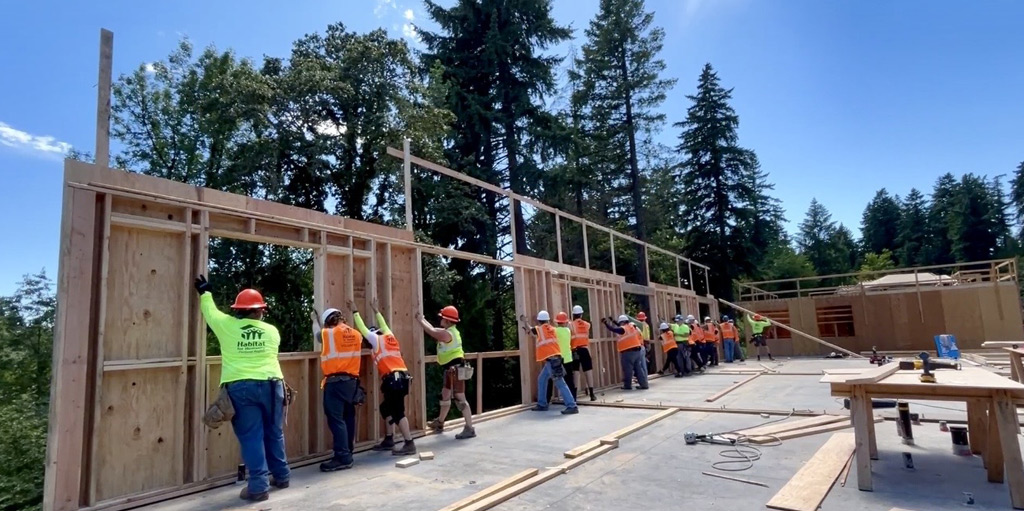 This week the first 500 Habitat for Humanity Emergency Shelter Kits arrived to Haiti. Emergency Shelter Kits are designed to help families make immediate repairs and construct emergency shelter. Materials in the kit include a bucket, a tarpualin, wire, rope, a pry bar, a mason’s chisel and trowel, gloves, nails, a hammer and a saw. The kits will be distributed to families by Habitat employees and partners.
This week the first 500 Habitat for Humanity Emergency Shelter Kits arrived to Haiti. Emergency Shelter Kits are designed to help families make immediate repairs and construct emergency shelter. Materials in the kit include a bucket, a tarpualin, wire, rope, a pry bar, a mason’s chisel and trowel, gloves, nails, a hammer and a saw. The kits will be distributed to families by Habitat employees and partners.
At this time volunteers are not being sent to Haiti. On Monday KATU news spoke with our executive director Steve Messinetti about this topic. Watch the clip.
To learn about Habitat for Humanity International’s commitment to rebuilding Haiti please download the Haiti FAQ.
About the Haiti Earthquake
The 7.0 earthquake and strong aftershocks that struck near Port-au-Prince on Tuesday, January 12 have added yet another dimension to the humanitarian crisis and poverty conditions faced by over 80% of Haitians. According to Reuters, the quake hit at a shallow depth of 6.2 miles, just ten miles from the capital city. A hospital and several schools on the island are reported to have collapsed, according to regional news sources. The local authorities have declared the country in a state of emergency. The number of affected persons is unknown. However, Haiti’s ambassador to the U.S. has called the quake a “catastrophe of major proportions.”
This is a major setback for the poorest country in the Western Hemisphere, with 55% of the population living on less than one U.S. dollar per day. In the last two years, political instability, food shortages, and tropical storms and hurricanes have made it impossible for Haitians to break the cycle of poverty. More than 50,000 homes were damaged or destroyed in last year’s storms, and no estimate is available yet as to the damages to Port-au-Prince and surrounding areas, the heaviest populated area of Haiti. Most Haitian homes are poorly constructed with walls built from poorly made concrete bricks, mud and stones, the roof from scrap wood and metal sheets, and dirt floors, making them unable to withstand a natural disaster of this magnitude.
What You Can Do to Help
You can help by sending in a special tithe donation to Habitat Haiti and bring hope to a country in such great need. Please know all 100% of tithe donations are sent to your global partners. Click here to make an online donation to Habitat for Humanity that is designated for earthquake relief in Haiti.
You can also help raise awareness and funds by inserting banner ads into your blogs or personal websites.
Habitat for Humanity’s Immediate and Long-Term Response
Basic needs such as health care, food, water and shelter are the most urgent following an event like an earthquake to try to mitigate harmful after-effects such as spread of disease and insecurity. Habitat for Humanity’s goal is to help low-income families in need of decent housing because of this disaster with an emergency humanitarian response of shelter kits, clean-up and rehabilitation.
Clean-up and cash-for-work
Habitat for Humanity plans to help in clean-up and rehabilitation efforts by mobilizing people to clear the way for shelter construction and home rehabilitation. The size of response will depend upon the amount of support we are able to mobilize. A clean up “cash for work” program would organize people in communities and provide them with tools (shovels, wheelbarrows, bars, etc, etc). People would clean up debris and salvage those materials that could be recycled in a shelter solution. This involvement in productive activity provides an influx of cash to those affected by the disaster to help them meet basic needs such as food, and also contributes to their mental health by providing them with a positive, proactive opportunity to help with recovery.
Emergency Shelter Kits
Emergency Shelter Kits are a basic package of materials (wall panels of either wood, composite such as reinforced plastic or fibrocement, or other materials; as well as sheets for roofs; nails; rope and a hammer). Although price will be determined by cost of materials, which often rise post-disaster, we estimate that the cost for distributing a kit per family will be US$950 per family.
The kits will be distributed to families by Habitat employees and partners who have been trained by Habitat in disaster response and construction techniques. Habitat for Humanity has been implementing vocational education programs in Haiti for the past three years and has a cadre of certified masons and carpenters ready to assist with shelter construction in Port-au-Prince.
Transitional shelters
In a next phase of response Habitat for Humanity plans to repair damaged homes and also rebuild using a transitional shelter model, whereby the shelter provides an immediate solution to a family but also provides a permanent base structure. The model adheres to international Sphere standards and the basic transitional shelter unit consists of a 17.5m2 home, a 2.5 meter porch, and a separate 4m2 latrine/shower unit. The design includes a concrete floor and structure (beams and partial wall), wall panels which can be converted later to a more permanent material, and a hurricane-resistant roof (metal sheets or micro-concrete) at an estimated price of between $2,000 to $3,000.

As the situation stabilizes, Habitat Haiti will build permanent homes for families who lost so much. Just as before the earthquake, Habitat Haiti will provide a variety of services to families ranging from new homes, progressive building initiatives like “core homes”, renovations and financial literacy.
Habitat for Humanity has been at work in Haiti for 26 years and will use its local expertise and mobilize resources as part of the long-term recovery building efforts.
Click here to make an online donation to Habitat for Humanity that is designated for earthquake relief in Haiti.


